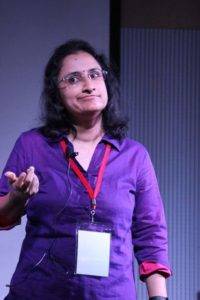
Radhika Nathan is the two novels ‘The Mute Anklet‘ and the ‘A time to Burnish‘ – both of them soaked in the history of South India. We spoke to her.
Radhika Nathan Author Interview
Tell us about yourself. Where did you grow up, what did you study and do you do anything other than writing?
Radhika Nathan: I grew up in Tamilnadu though I have lived outside the state for a longer period now. I am a science major but have always been an avid learner of various subjects. And I wish we had had the kind of online courses then that we have today. I read, listen to podcasts and am generally curious about a lot of things.
When did you first gravitate towards writing? Talk a bit about your writing journey so far.
Radhika Nathan: I wrote a few short stories when I was in college – material that I shared with my friends and family. I don’t remember being particularly diligent and if not for two of my friends, fellow writers themselves, who wrote a lot and challenged me to do so as well, I doubt that I would have written as much. Later, I blogged off and on for a while and then decided I needed a long-term commitment to writing. That got me to writing a novel. I have always been fascinated by language and words and storytelling in general. I have of late come to enjoy the process of writing – laboring over the right sentence to convey a mood, a thought, an idea… And I now know for sure I will continue to write irrespective of how the books do commercially.
Both your books – The Mute Anklet and A Time to burnish are rooted in history and specifically Tamil history – tell us what fascinates you in Tamil history?
Radhika Nathan: History, in general, fascinates me, be it about Attila the Hun or Boabdil or the Cholas. What fascinates me is that so much has changed, but at the same time nothing has changed. Be it sacrifice or aggression, be it love or hate, how familiar the emotions are even with the passing of hundreds of years. Which is why I like to have the historical events as the backdrop for stories about non-historical figures, stories that are not really alien. Artifacts being destroyed – is that really a thirteenth-century problem? Being judged for the skin color – is that really an eighteenth-century problem?
Fundamentally both my books are about personal conflicts – set to historical background. In “The Mute Anklet” it’s Uma coming to terms with her identity and in “A Time To Burnish” it is Josh coming to terms with his. I happened to pick Tamil (and Mysore) history because the setting, the climate, the customs are somewhat familiar to me.
How do you prepare for writing a narrative soaked in history?
Radhika Nathan: Honestly, it’s an exercise of restraint. What to leave so it doesn’t become an information dump. In “A Time To Burnish” I have hardly said anything about the Chola kings when you could fill hundreds of pages about them. It was a tough call not to have the protagonists visit the Thanjavur Big Temple, for example. Similarly, I just briefly touch upon the invasion in the thirteenth century. So, while I personally love history, I have been very mindful of the fact it’s fiction and not a history lesson. I read a lot, actually enjoy reading about the period. Whenever possible I visit the places I write about. I have never lived in Chennai but I did visit the places I describe. I also look at paintings from the period. For this book, I have visited many museums and have literally stared at tens of Natarajas.

What kind of research did you have to do for understanding Chola bronzes and for understanding the world of art trafficking? Which one was more difficult and why?
Radhika Nathan: That’s a very interesting question. Because when I started I thought I would find it easy to research about the bronzes and hard to understand about art trafficking. I strove to make the trafficking of the idol difficult, clever etc. Turns out, in real life, trafficking of artifacts from India is a piece of cake. Or at least, so it seemed when I read the newspaper accounts of 3-4 major heists. But the bronzes were a different story. The different schools of bronze making, the metallurgy behind it, the scientific and spiritual viewpoint of the Nataraja idol etc. were spread out. It was tough once again to figure out what to use and what not to. So, there is a page on the scientific view, another on the spiritual, another on the commercial value etc.
What led you to do a story on art trafficking? Did you come across an incident that inspired the story or did you read anything that made you enquire further?
Radhika Nathan: My father brought my attention to a newspaper story about an idol heist involving Subhash Kapoor. When I read the story I found it unbelievable the curators of the western museums or the private collectors didn’t realize that the idols were smuggled. Or if they did, didn’t come forward. I wondered what would have happened if one of them had a conscience. I have also been thinking about the sustainability of professions that does not involve technology. Those were the two thoughts that inspired this novel.
Romance is a highlight of your stories. In fact, A time to Burnish has a very Mills & Boons kind of romance through the story. How do you build characters who can lend heightened sensual experience to the reader?
Radhika Nathan: I like my characters to have a primary purpose other than romance, despite the fact that romance is a big part of the books. I try to build characters that are memorable, that go through some major change in the course of the events and can stand up for their views.
Historical fiction is a fast emerging genre in Indian literary world. Almost every era from history is being re-interpreted. What are your thoughts on the modern historical fiction?
Radhika Nathan: I think we have always had really great historical fiction in Indian languages. I am thrilled we have many books in English too now. Most of the books are clever and sensitive and immensely enjoyable.
What is your writing routine? Do you follow any rituals to meet your writing deadlines?
Radhika Nathan: I am actually not very disciplined about it. There are weeks when I would go without writing anything creative and then there would be a period when I would produce close to a thousand words a day. I usually do better during the beginning stages when I am just crafting the outline, characters, and events. I also do better when I do the final polishing. And I take an inordinate amount of time when it comes to getting it from the first draft to the fifth. I don’t have any rituals as such.
Tell us a bit about the next book/project that you are working on?
Radhika Nathan: I have been toying with the idea of writing something set in the mid to late twentieth century. Either in the 40s or in the late 70s. Still very nebulous. I have started buying books about the geopolitical that would inspire me with a knot.
Thank you, Radhika Nathan, for so sharing your views so candidly with us.









I love her writing. Mute anklet was one of kind. Thank you for this in-depth interview.
I also enjoy reading her Preethi.